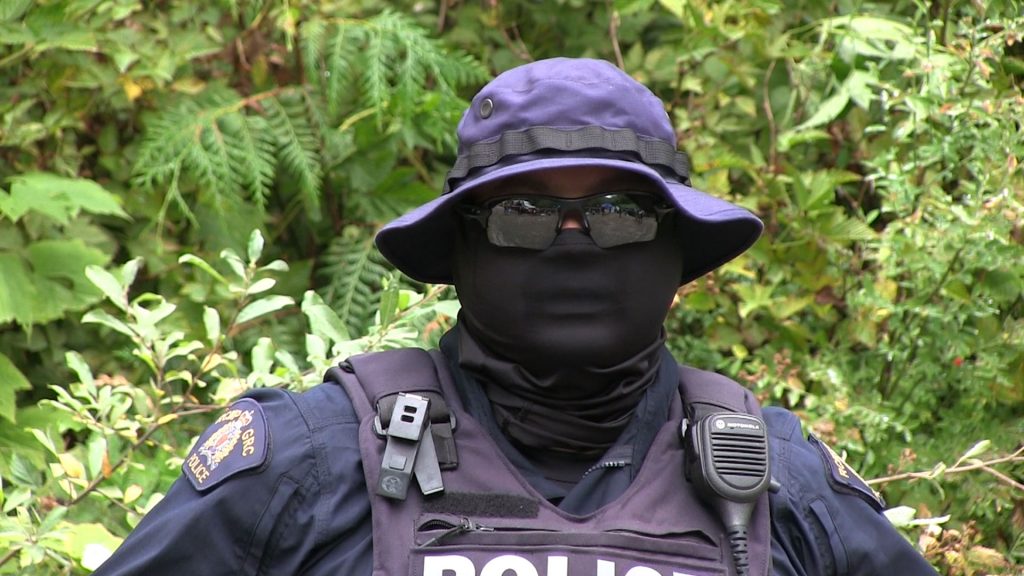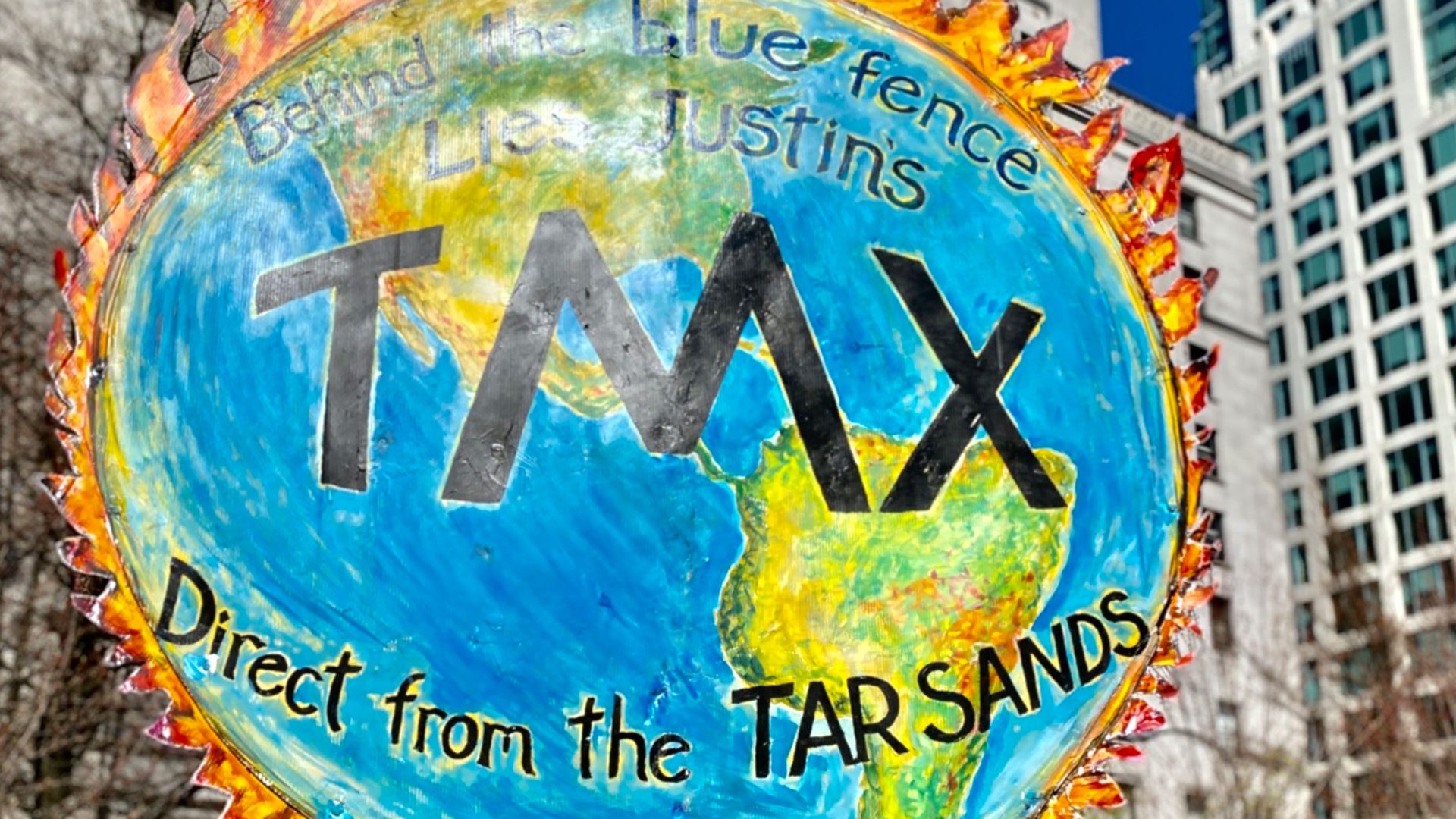
A Mountie deployed to enforce an injunction obtained by timber firm Teal-Jones at Fairy Creek in 2021. Photo: submitted/file
Exclusion zones, psychological manipulation, siege tactics and arbitrary detention. Theft of property, pain compliance and withholding the necessities of life. Unorthodox methods, excessive force and broken bones.
These are some of the alleged misdeeds uncovered by an APTN News investigation into the Community-Industry Response Group (C-IRG), an arm of the British Columbia RCMP established to monitor and quash resistance to resource extraction projects.
“They seem to be unrestrained in what they can do,” says Wet’suwet’en Hereditary Chief Na’Moks on the Nation to Nation podcast. “There seems to be no limit to the violence, the harassment and what they perceive as their duties.”
For three years, Na’Moks, also known as John Ridsdale, has watched the unit meet Wet’suwet’en efforts to assert their Aboriginal title with multi-million-dollar paramilitary raids.
After reading the Behind the Thin Blue Line investigation, Na’Moks says elected officials are turning a blind eye to the unit’s operations, giving it an unlimited leash and allowing it to run wild on unceded First Nations territory all over B.C.
“Where else in this country do you have people with snipers? Where else do you have dog units coming in? Where else do they come through your door with axes and power saws?” he asks.
“Indigenous rights are human rights — are violated 24 hours a day, seven days a week — and nobody is being held accountable. They’re not being reined in. They have no guidelines.”
APTN obtained thousands of pages of court files and releases from roughly two dozen federal and provincial freedom of information requests to paint a full picture of why this special outfit was created and how it operates.
The evidence indicates the C-IRG was created in late 2016 or early 2017 by the commanding officer of the B.C. RCMP in response to opposition to the Trans Mountain expansion (TMX) and Coastal GasLink (CGL) pipelines from First Nations and civil society groups.

In internal policing plans, the Mounties monitored anti-pipeline sentiment closely, predicting “protest-related activity” would greet the projects. They feared “radical environment activists,” provocateurs and professional protesters might eventually disrupt construction.
The B.C. Liberals under premier Christy Clark were still in charge at the time. Clark’s then-solicitor general Mike Morris told APTN he didn’t remember being briefed on or approving the new outfit.
“However,” he said in an email, “I will add that the formation of this unit did not require any approvals from the Solicitor General’s office as it was purely an operational matter under the purview of the RCMP.”
But even so, Na’Moks says politicians can no longer duck accountability. The hereditary chief of the Tsayu (Beaver) Clan has a direct and simple message for them.
“Take ownership and responsibility. That’s number one with us,” he says. “Answer the questions. Don’t plead ignorance … Don’t hide behind, ‘We didn’t know.’ Where’s your due diligence?”
APTN requested interviews with B.C. RCMP commanding officers a week ago. But no one was made available. The provincial Ministry of Public Safety also refused interview requests. APTN is still awaiting written responses to a list of questions.

Kanahus Manuel, a prominent activist and spokesperson for the Tiny House Warriors, believes Canada is allowing the Mounties to deal with Aboriginal title issues through colonial force.
“They’re there to do the dirty work for the Canadian government, to take resources and to take land,” Manuel says. “It’s not right. It’s human rights violations.”
The warriors have been occupying unceded Secwépemc territory along the TMX route near Blue River in the province’s interior. Like the Wet’suwet’en, they’ve been physically asserting title to the territory, as well as blocking the pipeline.
The area is about 700 kilometres southeast of the CGL raids, but it’s been the same group of senior Mounties directing operations for TMX against the warriors.
Manuel tells N2N it’s no coincidence British Columbia is the only province that has such a unique police squadron. Treaties were never signed in huge swaths of the province, meaning those areas are actually unsurrendered First Nations territory.
“It gives a real clear picture of the Canadian government and how they use their policing agencies to deal with the outstanding land question here in so-called British Columbia,” she says. “This has to stop.”
APTN’s investigation also revealed a broadening network of senior ex-Mounties, often with decades of experience, providing espionage and security services to resource extraction companies, and working closely with the C-IRG.
Manuel says they go together “hand in glove,” noting that private security personnel will often have more policing experience than the actual cops the C-IRG deploys.
Manuel also says, while the C-IRG is new, the federal police agency’s use of paramilitary force to crush Indigenous resistance is not.
Mounties used tanks, a land mine, fired some 77,000 rounds of live ammunition and launched a “disinformation and smear campaign” during the armed standoff at Gustafsen Lake in 1995.
There’s never been a public inquiry into those events — something Manuel is calling for now.

Lawyer Noah Ross represents more than 100 people arrested by the C-IRG during blockades against old-growth logging at Fairy Creek on Vancouver Island.
They contend police engaged in a sweeping and systematic campaign of human rights abuses that was “so shocking” the court must toss out their charges to save its reputation.
Ross’s clients allege the C-IRG went beyond simply enforcing an injunction by launching a politically motivated pro-industry campaign aimed at crushing the backbone of the environmental movement itself.
“If some of our allegations are proven, it appears that they went beyond their authority to achieve a certain end goal,” Ross tells N2N. “That’s not what we want policing to do.
“If policy is unpopular and there’s public disagreement over it, then resorting to illegality to enforce the outcome of it — (especially) from the RCMP, where they have so much of an inequality of violence at their disposal — it’s problematic.”
Ross has a similar opinion when asked what the provincial or federal government should do to provide accountability and oversight for the C-IRG: Rein it in or phase it out.
Ross says the provincial government, an NDP majority led by Premier John Horgan, could and should order a probe into the C-IRG’s activities.
“It’s time for the NDP to look at that unit and whether or not they’re fulfilling what they’re intending to fulfil,” says Ross.
And if the C-IRG isn’t achieving the objectives it set out to, he believes it should be disbanded.
Listen to all three interviews above on the N2N podcast.












